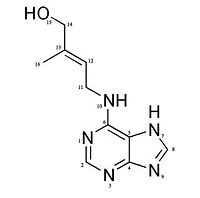Editing User:Pauline Hanns/Sandbox 1
From Proteopedia
(Difference between revisions)
| Line 53: | Line 53: | ||
The reductive part of reaction is '''fast''', as a consequence it is the '''reoxidation of the FAD cofactor''' which constitute the '''rate limiting step''' for the catalytic action of the CKX enzyme. <ref name="Kopečnýa3">PMID: 15927342 </ref> In absence of organic electron acceptor, oxygen can be used but it is a poor electron acceptor, so this shows that the regeneration of free radicals is an important step. The coupling of CKX with laccase or peroxidase involves that the regulation of the CKX activity is '''highly dependent of the regulation of these two enzymes.''' | The reductive part of reaction is '''fast''', as a consequence it is the '''reoxidation of the FAD cofactor''' which constitute the '''rate limiting step''' for the catalytic action of the CKX enzyme. <ref name="Kopečnýa3">PMID: 15927342 </ref> In absence of organic electron acceptor, oxygen can be used but it is a poor electron acceptor, so this shows that the regeneration of free radicals is an important step. The coupling of CKX with laccase or peroxidase involves that the regulation of the CKX activity is '''highly dependent of the regulation of these two enzymes.''' | ||
| - | Different in-vivo '''competitive inhibitors''' of the CKX have been identified such as | + | Different in-vivo '''competitive inhibitors''' of the CKX have been identified such as [http://www.chemspider.com/Chemical-Structure.7314.html 1,3-Diphenylurea] and derivatives such as [http://www.chemspider.com/Chemical-Structure.84301.html CPPU] and [http://www.chemspider.com/Chemical-Structure.36635.html?rid=297591f4-cdf2-4512-b292-c70b3a098343 thidiazuron] <ref name="Frebortova">PMID: 19912568 </ref>, which are known as cytokinin agonists <ref name="Kopečnýa3">PMID: 15927342 </ref> or Urea-type cytokinins.<ref name="Kopečnýa">PMID: 20478354 </ref> |
Another type of regulation is made by '''glycosylation''' : CKX has indeed '''five asparagine''' residues which can be glycosylated: <scene name='68/686754/Glycosylation2/1'>Asn63, Asn134, Asn294, Asn323 and Asn338</scene>. Protein glycosylation is particularly important since it regulates the '''enzymatic activity''' and the '''protein stability''' <ref name="Kopečnýa">PMID: 20478354 </ref><ref name="Schmülling">PMID: 12721786 </ref> and it was suggested, it has a role for '''enzyme localization'''. <ref name="Frebortova">PMID: 19912568 </ref> | Another type of regulation is made by '''glycosylation''' : CKX has indeed '''five asparagine''' residues which can be glycosylated: <scene name='68/686754/Glycosylation2/1'>Asn63, Asn134, Asn294, Asn323 and Asn338</scene>. Protein glycosylation is particularly important since it regulates the '''enzymatic activity''' and the '''protein stability''' <ref name="Kopečnýa">PMID: 20478354 </ref><ref name="Schmülling">PMID: 12721786 </ref> and it was suggested, it has a role for '''enzyme localization'''. <ref name="Frebortova">PMID: 19912568 </ref> | ||
Revision as of 15:08, 9 January 2015
2qkn
Crystal structure of Maize cytokinin oxidase/dehydrogenase complexed with phenylurea inhibitor CPPU
| |||||||||||
References
- ↑ 1.0 1.1 1.2 1.3 1.4 Frebortova J, Novak O, Frebort I, Jorda R. Degradation of cytokinins by maize cytokinin dehydrogenase is mediated by free radicals generated by enzymatic oxidation of natural benzoxazinones. Plant J. 2010 Feb 1;61(3):467-81. doi: 10.1111/j.1365-313X.2009.04071.x. Epub, 2009 Nov 14. PMID:19912568 doi:http://dx.doi.org/10.1111/j.1365-313X.2009.04071.x
- ↑ 2.0 2.1 2.2 2.3 2.4 2.5 2.6 Kopecny D, Briozzo P, Popelkova H, Sebela M, Koncitikova R, Spichal L, Nisler J, Madzak C, Frebort I, Laloue M, Houba-Herin N. Phenyl- and benzylurea cytokinins as competitive inhibitors of cytokinin oxidase/dehydrogenase: a structural study. Biochimie. 2010 Aug;92(8):1052-62. Epub 2010 May 15. PMID:20478354 doi:10.1016/j.biochi.2010.05.006
- ↑ Kopecny D, Sebela M, Briozzo P, Spichal L, Houba-Herin N, Masek V, Joly N, Madzak C, Anzenbacher P, Laloue M. Mechanism-based inhibitors of cytokinin oxidase/dehydrogenase attack FAD cofactor. J Mol Biol. 2008 Jul 25;380(5):886-99. Epub 2008 May 24. PMID:18571199 doi:10.1016/j.jmb.2008.05.044
- ↑ 4.0 4.1 4.2 4.3 Kopecny D, Pethe C, Sebela M, Houba-Herin N, Madzak C, Majira A, Laloue M. High-level expression and characterization of Zea mays cytokinin oxidase/dehydrogenase in Yarrowia lipolytica. Biochimie. 2005 Nov;87(11):1011-22. PMID:15927342 doi:http://dx.doi.org/10.1016/j.biochi.2005.04.006
- ↑ 5.0 5.1 5.2 5.3 5.4 Malito E, Coda A, Bilyeu KD, Fraaije MW, Mattevi A. Structures of Michaelis and product complexes of plant cytokinin dehydrogenase: implications for flavoenzyme catalysis. J Mol Biol. 2004 Aug 27;341(5):1237-49. PMID:15321719 doi:http://dx.doi.org/10.1016/j.jmb.2004.06.083
- ↑ 6.0 6.1 Schmulling T, Werner T, Riefler M, Krupkova E, Bartrina y Manns I. Structure and function of cytokinin oxidase/dehydrogenase genes of maize, rice, Arabidopsis and other species. J Plant Res. 2003 Jun;116(3):241-52. Epub 2003 Apr 29. PMID:12721786 doi:http://dx.doi.org/10.1007/s10265-003-0096-4


